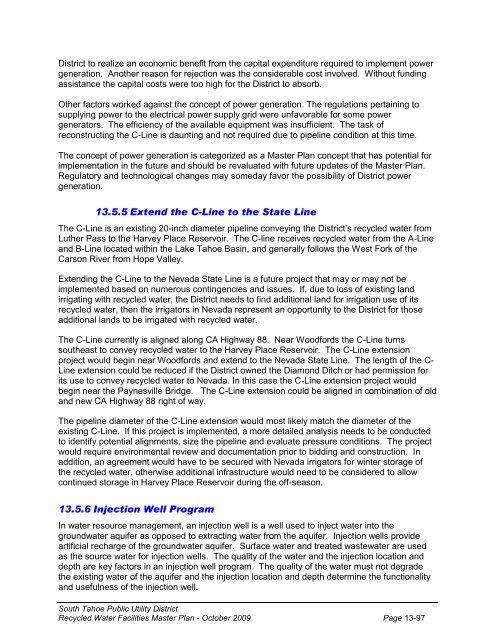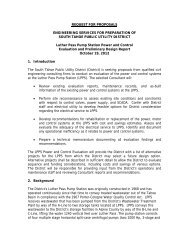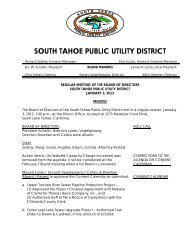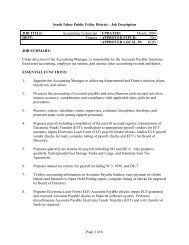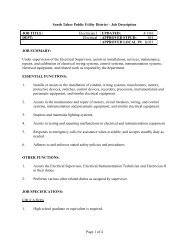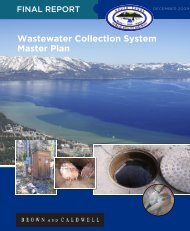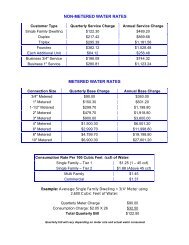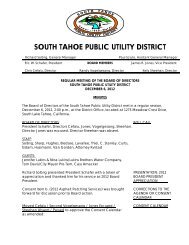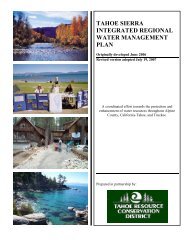October 2009 - South Tahoe Public Utility District
October 2009 - South Tahoe Public Utility District
October 2009 - South Tahoe Public Utility District
You also want an ePaper? Increase the reach of your titles
YUMPU automatically turns print PDFs into web optimized ePapers that Google loves.
<strong>District</strong> to realize an economic benefit from the capital expenditure required to implement power<br />
generation. Another reason for rejection was the considerable cost involved. Without funding<br />
assistance the capital costs were too high for the <strong>District</strong> to absorb.<br />
Other factors worked against the concept of power generation. The regulations pertaining to<br />
supplying power to the electrical power supply grid were unfavorable for some power<br />
generators. The efficiency of the available equipment was insufficient. The task of<br />
reconstructing the C-Line is daunting and not required due to pipeline condition at this time.<br />
The concept of power generation is categorized as a Master Plan concept that has potential for<br />
implementation in the future and should be revaluated with future updates of the Master Plan.<br />
Regulatory and technological changes may someday favor the possibility of <strong>District</strong> power<br />
generation.<br />
13.5.5 Extend the C-Line to the State Line<br />
The C-Line is an existing 20-inch diameter pipeline conveying the <strong>District</strong>‟s recycled water from<br />
Luther Pass to the Harvey Place Reservoir. The C-line receives recycled water from the A-Line<br />
and B-Line located within the Lake <strong>Tahoe</strong> Basin, and generally follows the West Fork of the<br />
Carson River from Hope Valley.<br />
Extending the C-Line to the Nevada State Line is a future project that may or may not be<br />
implemented based on numerous contingencies and issues. If, due to loss of existing land<br />
irrigating with recycled water, the <strong>District</strong> needs to find additional land for irrigation use of its<br />
recycled water, then the irrigators in Nevada represent an opportunity to the <strong>District</strong> for those<br />
additional lands to be irrigated with recycled water.<br />
The C-Line currently is aligned along CA Highway 88. Near Woodfords the C-Line turns<br />
southeast to convey recycled water to the Harvey Place Reservoir. The C-Line extension<br />
project would begin near Woodfords and extend to the Nevada State Line. The length of the C-<br />
Line extension could be reduced if the <strong>District</strong> owned the Diamond Ditch or had permission for<br />
its use to convey recycled water to Nevada. In this case the C-Line extension project would<br />
begin near the Paynesville Bridge. The C-Line extension could be aligned in combination of old<br />
and new CA Highway 88 right of way.<br />
The pipeline diameter of the C-Line extension would most likely match the diameter of the<br />
existing C-Line. If this project is implemented, a more detailed analysis needs to be conducted<br />
to identify potential alignments, size the pipeline and evaluate pressure conditions. The project<br />
would require environmental review and documentation prior to bidding and construction. In<br />
addition, an agreement would have to be secured with Nevada irrigators for winter storage of<br />
the recycled water, otherwise additional infrastructure would need to be considered to allow<br />
continued storage in Harvey Place Reservoir during the off-season.<br />
13.5.6 Injection Well Program<br />
In water resource management, an injection well is a well used to inject water into the<br />
groundwater aquifer as opposed to extracting water from the aquifer. Injection wells provide<br />
artificial recharge of the groundwater aquifer. Surface water and treated wastewater are used<br />
as the source water for injection wells. The quality of the water and the injection location and<br />
depth are key factors in an injection well program. The quality of the water must not degrade<br />
the existing water of the aquifer and the injection location and depth determine the functionality<br />
and usefulness of the injection well.<br />
<strong>South</strong> <strong>Tahoe</strong> <strong>Public</strong> <strong>Utility</strong> <strong>District</strong><br />
Recycled Water Facilities Master Plan - <strong>October</strong> <strong>2009</strong> Page 13-97


